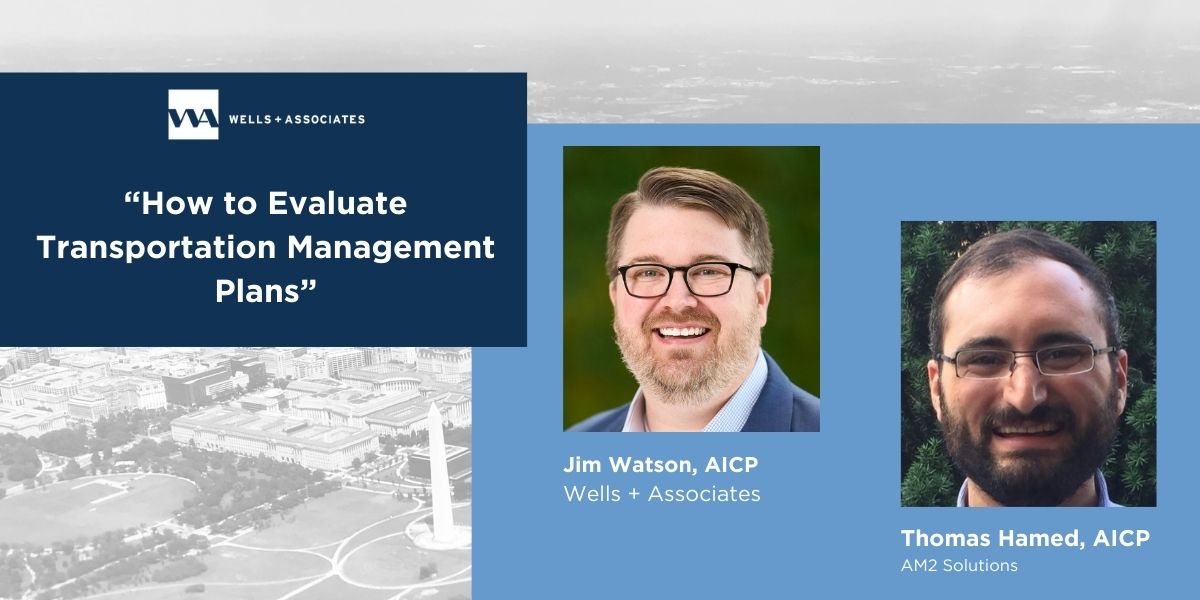On, Tuesday, May 14, 2024, Thomas Hamed of AM2 Solutions and Jim Watson, Principal at Wells + Associates, will present on “Evaluating Transportation Management Plans for Federal Worksites” at the APA Federal Planning Division’s 2024 Training Workshop Program in Washington, DC.
Their session will educate planners on how to evaluate Transportation Management Plans (TMP), which are required for many federal worksites in the National Capital Region (NCR) to ease congestion and promote multimodal environments.
In the lead-up to this session, we’ve asked Jim and Thomas to review TMPs and the role they can play in improving transportation to and from federal workplaces in this Q&A.
Q: Within the context of transportation planning for Federal Government facilities, what is a Transportation Management Plan (TMP)?
A (Jim Watson):
Rooted in the National Capital Planning Act of 1952, TMPs are required for Federal facilities in the NCR as a part of the master planning process. The National Capital Planning Commission (NCPC) established guidelines in collaboration with the Metropolitan Washington Council of Governments in their 2021 TMP Handbook.
Q: What are TMPs supposed to achieve?
A (Jim Watson):
While transportation strategies for facilities and their tenant agencies can range based on mission, setting, population, and other factors, the strategies employed in TMPs should help Federal facilities and their tenant agencies to ensure access for users, assess sustainability targets, manage real estate, and meet NCPC parking ratio goals.
Q: How do TMPs relate to large federal worksites? Do they help large facilities provide alternatives to single-occupancy-vehicle commuting?
A (Jim Watson):
TMPs are particularly critical for large Federal worksites such as the Pentagon, Mark Center, those facilities in the Suitland Federal Center, and other facilities around the NCR that rely on significant numbers of employees commuting to work. Given the real estate constraints of urban and suburban sites as well as parking ratio goals for Federal facilities in the NCR, mode choice is a significant element for federal commuters. A robust TMP can outline a roadmap for federal facilities and its workforce, improving modal choice and convenience for the worksite’s commuters.
Q: If I am a [facility/transportation manager] of a federal facility or worksite, how should I approach making use of a TMP evaluation?
A (Thomas Hamed):
An agency or facility’s approved TMP should be first consulted as a guide – what does it require of those implementing the TMP? Generally, the TMP evaluation should consist of a review of the facility’s transportation conditions (mode split, parking utilization, TDM strategies, surrounding transportation improvements and land uses) augmented by an assessment of how the facility is meeting the goals of the approved TMP and recommendations on how to improve upon the facility’s conditions. Most importantly, policy recommendations should be framed as improvements to facility or agency leadership.
Q: What data should go into a TMP evaluation?
A (Thomas Hamed):
It’s important to think of what data streams are available in a TMP. The following data can be helpful in assessing a facility’s transportation conditions:
- Transit use or frequency, such as a General Transit Feed Specification (GTFS)
- Bicycle rack utilization
- Badge-in data, some of which the media cites
- Parking utilization
- Survey of facility employees, if possible
- Development activity near the facility
- Transportation improvements impacting facility commuters

